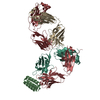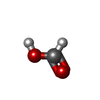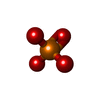[English] 日本語
 Yorodumi
Yorodumi- PDB-8s1x: Crystal structure of Actinonin-bound PDF1 and the computationally... -
+ Open data
Open data
- Basic information
Basic information
| Entry | Database: PDB / ID: 8s1x | |||||||||
|---|---|---|---|---|---|---|---|---|---|---|
| Title | Crystal structure of Actinonin-bound PDF1 and the computationally designed DBAct553_1 protein binder | |||||||||
 Components Components |
| |||||||||
 Keywords Keywords | DE NOVO PROTEIN / Actinonin / de novo / computational / binder / CID / switch / deformylase | |||||||||
| Function / homology |  Function and homology information Function and homology informationpeptide deformylase / peptide deformylase activity / : / translation / metal ion binding Similarity search - Function | |||||||||
| Biological species |  synthetic construct (others) | |||||||||
| Method |  X-RAY DIFFRACTION / X-RAY DIFFRACTION /  SYNCHROTRON / SYNCHROTRON /  MOLECULAR REPLACEMENT / Resolution: 1.88 Å MOLECULAR REPLACEMENT / Resolution: 1.88 Å | |||||||||
 Authors Authors | Marchand, A. / Pacesa, M. / Correia, B.E. | |||||||||
| Funding support | European Union,  Switzerland, 2items Switzerland, 2items
| |||||||||
 Citation Citation |  Journal: Nature / Year: 2025 Journal: Nature / Year: 2025Title: Targeting protein-ligand neosurfaces with a generalizable deep learning tool. Authors: Anthony Marchand / Stephen Buckley / Arne Schneuing / Martin Pacesa / Maddalena Elia / Pablo Gainza / Evgenia Elizarova / Rebecca M Neeser / Pao-Wan Lee / Luc Reymond / Yangyang Miao / Leo ...Authors: Anthony Marchand / Stephen Buckley / Arne Schneuing / Martin Pacesa / Maddalena Elia / Pablo Gainza / Evgenia Elizarova / Rebecca M Neeser / Pao-Wan Lee / Luc Reymond / Yangyang Miao / Leo Scheller / Sandrine Georgeon / Joseph Schmidt / Philippe Schwaller / Sebastian J Maerkl / Michael Bronstein / Bruno E Correia /     Abstract: Molecular recognition events between proteins drive biological processes in living systems. However, higher levels of mechanistic regulation have emerged, in which protein-protein interactions are ...Molecular recognition events between proteins drive biological processes in living systems. However, higher levels of mechanistic regulation have emerged, in which protein-protein interactions are conditioned to small molecules. Despite recent advances, computational tools for the design of new chemically induced protein interactions have remained a challenging task for the field. Here we present a computational strategy for the design of proteins that target neosurfaces, that is, surfaces arising from protein-ligand complexes. To develop this strategy, we leveraged a geometric deep learning approach based on learned molecular surface representations and experimentally validated binders against three drug-bound protein complexes: Bcl2-venetoclax, DB3-progesterone and PDF1-actinonin. All binders demonstrated high affinities and accurate specificities, as assessed by mutational and structural characterization. Remarkably, surface fingerprints previously trained only on proteins could be applied to neosurfaces induced by interactions with small molecules, providing a powerful demonstration of generalizability that is uncommon in other deep learning approaches. We anticipate that such designed chemically induced protein interactions will have the potential to expand the sensing repertoire and the assembly of new synthetic pathways in engineered cells for innovative drug-controlled cell-based therapies. | |||||||||
| History |
|
- Structure visualization
Structure visualization
| Structure viewer | Molecule:  Molmil Molmil Jmol/JSmol Jmol/JSmol |
|---|
- Downloads & links
Downloads & links
- Download
Download
| PDBx/mmCIF format |  8s1x.cif.gz 8s1x.cif.gz | 158.8 KB | Display |  PDBx/mmCIF format PDBx/mmCIF format |
|---|---|---|---|---|
| PDB format |  pdb8s1x.ent.gz pdb8s1x.ent.gz | 122.2 KB | Display |  PDB format PDB format |
| PDBx/mmJSON format |  8s1x.json.gz 8s1x.json.gz | Tree view |  PDBx/mmJSON format PDBx/mmJSON format | |
| Others |  Other downloads Other downloads |
-Validation report
| Summary document |  8s1x_validation.pdf.gz 8s1x_validation.pdf.gz | 791.1 KB | Display |  wwPDB validaton report wwPDB validaton report |
|---|---|---|---|---|
| Full document |  8s1x_full_validation.pdf.gz 8s1x_full_validation.pdf.gz | 791.9 KB | Display | |
| Data in XML |  8s1x_validation.xml.gz 8s1x_validation.xml.gz | 13.4 KB | Display | |
| Data in CIF |  8s1x_validation.cif.gz 8s1x_validation.cif.gz | 17.1 KB | Display | |
| Arichive directory |  https://data.pdbj.org/pub/pdb/validation_reports/s1/8s1x https://data.pdbj.org/pub/pdb/validation_reports/s1/8s1x ftp://data.pdbj.org/pub/pdb/validation_reports/s1/8s1x ftp://data.pdbj.org/pub/pdb/validation_reports/s1/8s1x | HTTPS FTP |
-Related structure data
| Related structure data |  9fkdC C: citing same article ( |
|---|---|
| Similar structure data | Similarity search - Function & homology  F&H Search F&H Search |
- Links
Links
- Assembly
Assembly
| Deposited unit | 
| ||||||||||||
|---|---|---|---|---|---|---|---|---|---|---|---|---|---|
| 1 |
| ||||||||||||
| Unit cell |
|
- Components
Components
-Protein , 2 types, 2 molecules AB
| #1: Protein | Mass: 19391.156 Da / Num. of mol.: 1 Source method: isolated from a genetically manipulated source Details: Actionin / Source: (gene. exp.)   |
|---|---|
| #2: Protein | Mass: 8152.354 Da / Num. of mol.: 1 Source method: isolated from a genetically manipulated source Details: Actionin / Source: (gene. exp.) synthetic construct (others) / Production host:  |
-Non-polymers , 6 types, 91 molecules 










| #3: Chemical | ChemComp-ZN / | ||||||
|---|---|---|---|---|---|---|---|
| #4: Chemical | ChemComp-BB2 / | ||||||
| #5: Chemical | ChemComp-FMT / #6: Chemical | ChemComp-PO4 / #7: Chemical | ChemComp-K / | #8: Water | ChemComp-HOH / | |
-Details
| Has ligand of interest | Y |
|---|---|
| Has protein modification | N |
-Experimental details
-Experiment
| Experiment | Method:  X-RAY DIFFRACTION / Number of used crystals: 1 X-RAY DIFFRACTION / Number of used crystals: 1 |
|---|
- Sample preparation
Sample preparation
| Crystal | Density Matthews: 2.8 Å3/Da / Density % sol: 56.06 % |
|---|---|
| Crystal grow | Temperature: 291.15 K / Method: vapor diffusion, sitting drop / pH: 6.2 Details: 0.2 M Sodium Formate, 0.1 M Sodium Phosphate pH 6.2, 20% (v/v) PEG smear, 10% (v/v) glycerol |
-Data collection
| Diffraction | Mean temperature: 100 K / Serial crystal experiment: N |
|---|---|
| Diffraction source | Source:  SYNCHROTRON / Site: SYNCHROTRON / Site:  ESRF ESRF  / Beamline: MASSIF-1 / Wavelength: 0.87313 Å / Beamline: MASSIF-1 / Wavelength: 0.87313 Å |
| Detector | Type: DECTRIS PILATUS3 2M / Detector: PIXEL / Date: Feb 11, 2024 |
| Radiation | Protocol: SINGLE WAVELENGTH / Monochromatic (M) / Laue (L): M / Scattering type: x-ray |
| Radiation wavelength | Wavelength: 0.87313 Å / Relative weight: 1 |
| Reflection | Resolution: 1.88→55.7 Å / Num. obs: 24990 / % possible obs: 96.9 % / Redundancy: 4.3 % / Biso Wilson estimate: 44.77 Å2 / CC1/2: 0.999 / Rmerge(I) obs: 0.044 / Net I/σ(I): 15 |
| Reflection shell | Resolution: 1.88→1.91 Å / Redundancy: 4.4 % / Rmerge(I) obs: 1.125 / Mean I/σ(I) obs: 1.3 / Num. unique obs: 1266 / CC1/2: 0.426 / % possible all: 99.6 |
- Processing
Processing
| Software |
| ||||||||||||||||||||||||||||||||||||||||||||||||||||||||||||||||||||||
|---|---|---|---|---|---|---|---|---|---|---|---|---|---|---|---|---|---|---|---|---|---|---|---|---|---|---|---|---|---|---|---|---|---|---|---|---|---|---|---|---|---|---|---|---|---|---|---|---|---|---|---|---|---|---|---|---|---|---|---|---|---|---|---|---|---|---|---|---|---|---|---|
| Refinement | Method to determine structure:  MOLECULAR REPLACEMENT / Resolution: 1.88→55.7 Å / SU ML: 0.2366 / Cross valid method: FREE R-VALUE / σ(F): 1.34 / Phase error: 21.4881 MOLECULAR REPLACEMENT / Resolution: 1.88→55.7 Å / SU ML: 0.2366 / Cross valid method: FREE R-VALUE / σ(F): 1.34 / Phase error: 21.4881 Stereochemistry target values: GeoStd + Monomer Library + CDL v1.2
| ||||||||||||||||||||||||||||||||||||||||||||||||||||||||||||||||||||||
| Solvent computation | Shrinkage radii: 0.9 Å / VDW probe radii: 1.1 Å / Solvent model: FLAT BULK SOLVENT MODEL | ||||||||||||||||||||||||||||||||||||||||||||||||||||||||||||||||||||||
| Displacement parameters | Biso mean: 57.21 Å2 | ||||||||||||||||||||||||||||||||||||||||||||||||||||||||||||||||||||||
| Refinement step | Cycle: LAST / Resolution: 1.88→55.7 Å
| ||||||||||||||||||||||||||||||||||||||||||||||||||||||||||||||||||||||
| Refine LS restraints |
| ||||||||||||||||||||||||||||||||||||||||||||||||||||||||||||||||||||||
| LS refinement shell |
|
 Movie
Movie Controller
Controller



 PDBj
PDBj





